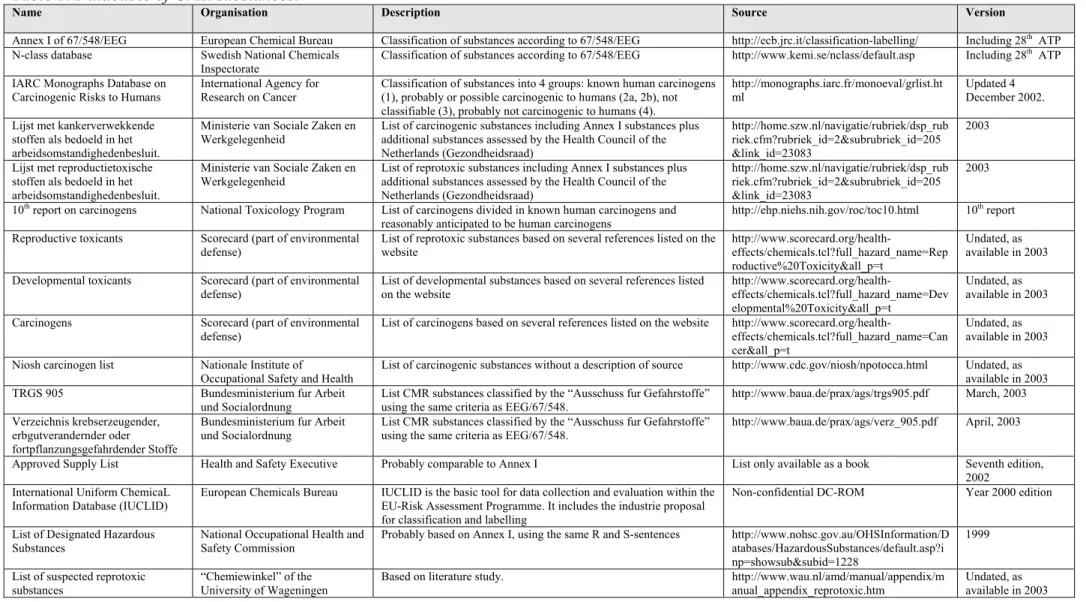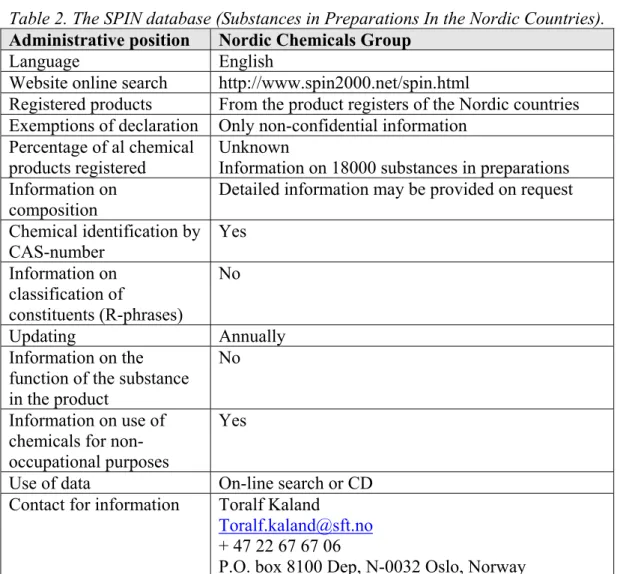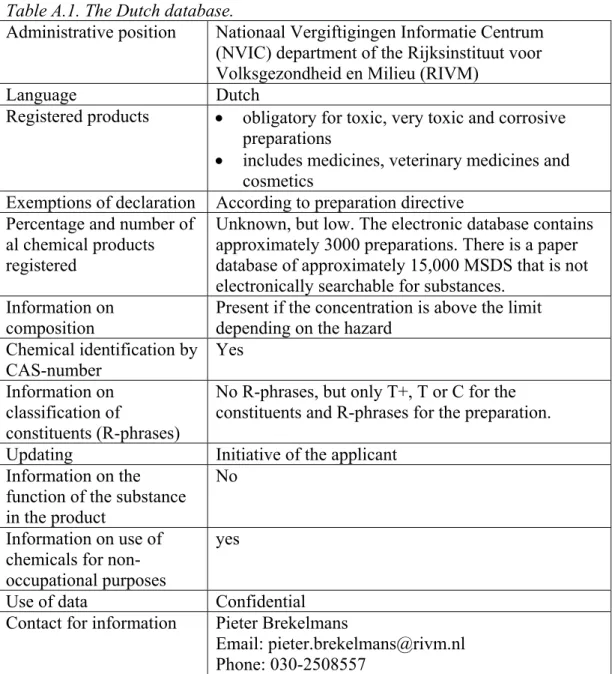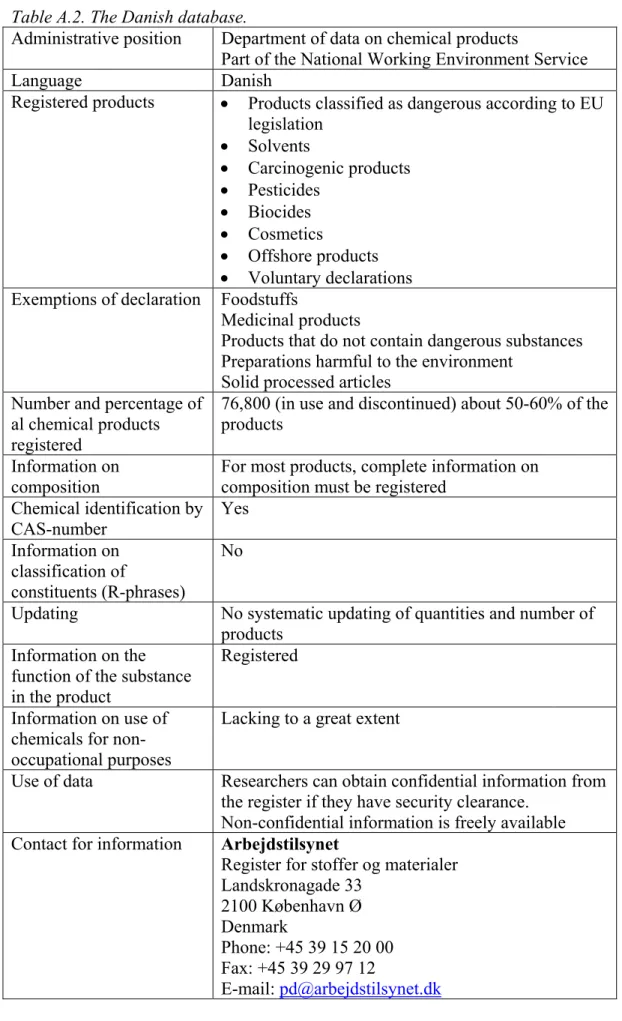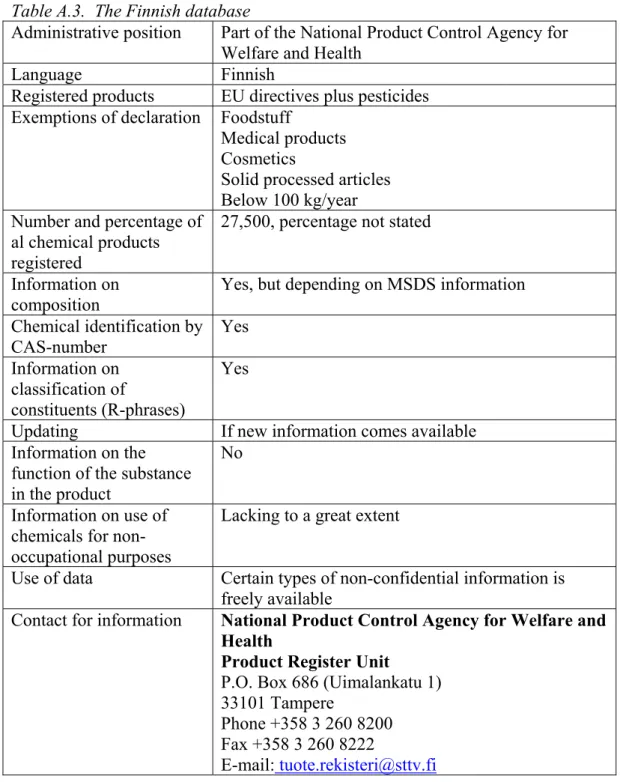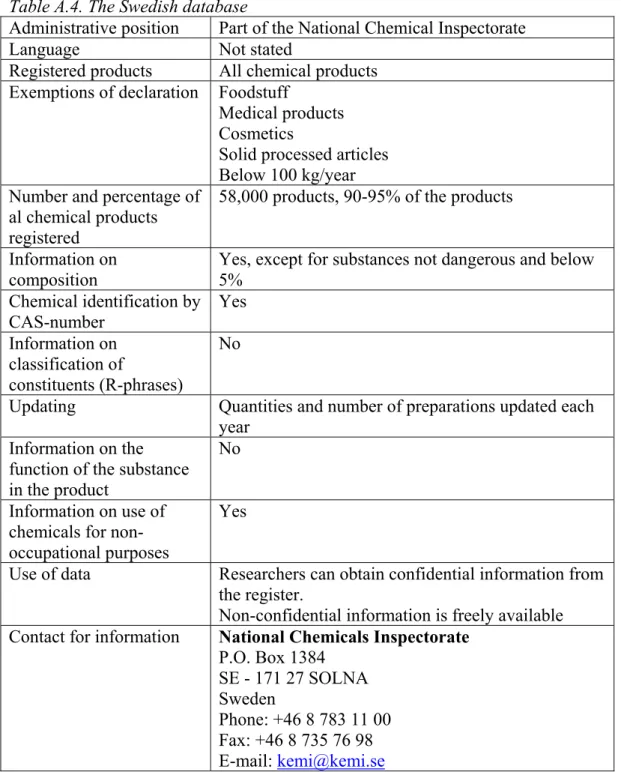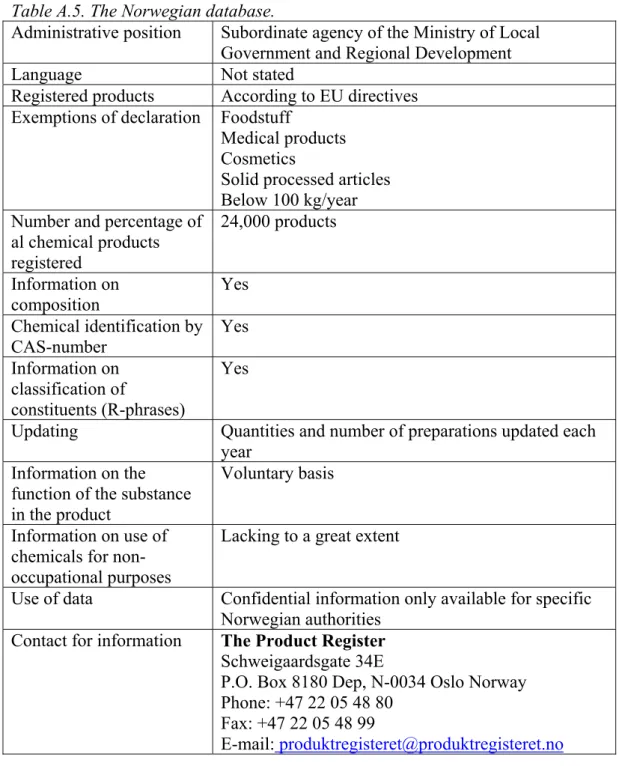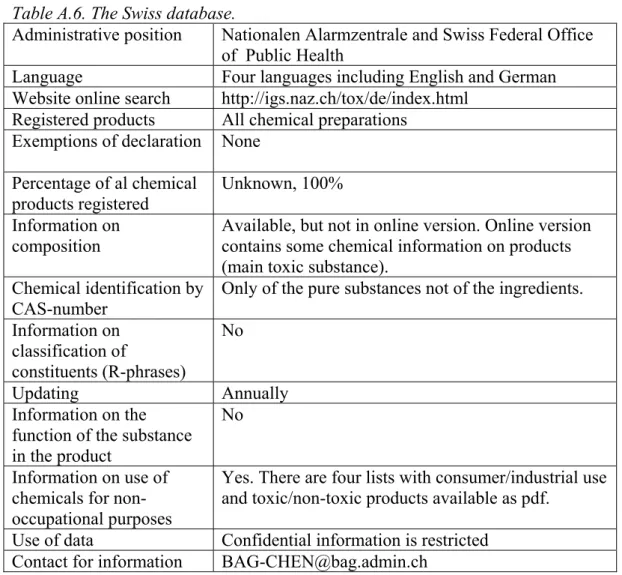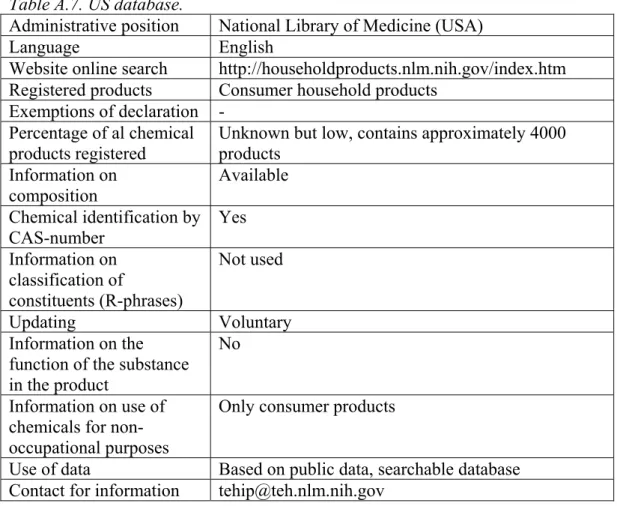and Reprotoxic (CMR) substances in consumer preparations
J.J.A. Muller, P.M.J. Bos
This investigation has been performed by order and for the account of the Ministry of Health, Welfare and Sport, within the framework of project V/320010, ‘Risk assessment and risk reduction of substances in consumer products’.
page 2 of 63 RIVM report 320010001
Abstract
The general public is protected from the effects of Carcinogenic, Mutagenic and Reprotoxic (CMR) substances partly by banning the sale of preparations containing classified CMR substances (Annex I of 67/548/EEC) at levels above the limit concentration for exposure of the general public. It is therefore important that consumer preparations are checked for the presence of these substances and that, in addition, potential CMR substances are assessed for inclusion in Annex I of 67/548/EEC. A search was made for potential CMR substances in electronically accessible databases, after which a list of 514 potential CMR substances not found in Annex 1 could be compiled. The occurrence of CMR category 1 and 2 substances, and of additional potential CMR substances, in consumer preparations was checked against the SPIN database, an initiative of the Nordic countries. A total of 146 Annex I substances for the CMR categories 1 and 2, and 24 potential CMR substances were found to be present in consumer preparations used in the Nordic countries. It cannot be ruled out that these substances will also be present in consumer preparations used in the Netherlands. A
quantitative estimate of the potential exposure to CMR substances was not possible due to the lack of an adequate database of consumer preparations showing actual concentrations.
Contents
Samenvatting 4 Summary 5
1. Introduction 7 2. Methods 9
2.1 Compilation of the lists of CMR substances 9
2.1.1 List of classified CMR substances 9 2.1.2 Additional list of CMR substances 9
2.1.3 Compilation of the list of potential CMR substances 9
2.2 Product registers 10
3. Results 11
3.1 Lists of (potential) CMR substances 11 3.2 Choice of product register 11
3.3 Lists of classified and potential CMR substances occurring in consumer preparations 12
4. Discussion 15
4.1 List of potential CMR substances 15
4.2 Presence of classified CMR substances in consumer preparations. 16 4.3 Presence of potential CMR substances in consumer preparations. 17 4.4 List of consumer preparations containing (potential) CMR substances 17
Appendix 1 List of potential CMR substances 19 Appendix 2 Description of the SPIN database 36 Appendix 3 Summary of available product registers 43
Appendix 4 List of classified CMR substances present in consumer preparations 50 Appendix 5 List of potential CMR substances present in consumer preparations 57 Appendix 6 The use of 2-ethoxyethanol in consumer preparations 58
Appendix 7 The use of benzene in consumer preparations 59
page 4 of 63 RIVM report 320010001
Samenvatting
Bescherming van de algemene bevolking tegen de gezondheidsnadelige effecten van carcinogene, mutagene en reproductietoxische stoffen (CMR stoffen) wordt mede
gerealiseerd door een verbod op de verkoop van consumentenpreparaten met te hoge gehalten aan CMR categorie 1 en 2 stoffen (Annex I van 67/548/EEG). Het is derhalve belangrijk dat zowel inzicht wordt verkregen in de volledigheid van deze lijst als in het voorkomen van dergelijke stoffen in consumentenpreparaten. Hiertoe werd gezocht naar elektronisch toegankelijke databestanden met lijsten van (mogelijke) CMR stoffen (in aanvulling op de Annex I) of met informatie over het voorkomen van dergelijke stoffen in
consumentenpreparaten. Het onderhavige project had als doel lijsten op te stellen van: a) potentiële CMR stoffen in aanvulling op CMR categorie 1 en 2 stoffen van Annex I, b) CMR categorie 1 en 2 stoffen en potentiële CMR stoffen die voorkomen in consumentenpreparaten en c) consumentenpreparaten die in belangrijke mate bijdragen aan de blootstelling van de Nederlandse bevolking aan (potentiële) CMR stoffen.
Op basis van diverse databestanden van (inter)nationale organisaties en instituten kon een lijst worden opgesteld van 514 potentiële CMR stoffen die niet op Annex I voorkomen. Het enige elektronisch toegankelijke databestand die geschikt was om het voorkomen van CMR stoffen te analyseren is het SPIN databestand, een initiatief van de Scandinavische landen. Op basis van dit bestand bleken 24 van de 514 potentiële CMR stoffen voor te komen in
consumentenpreparaten.
De aanwezigheid van CMR categorie 1 en 2 stoffen in consumentenpreparaten werd
eveneens geanalyseerd aan de hand van het SPIN databestand. In totaal 146 van deze stoffen bleken voor te komen in consumentenpreparaten. Hoewel het SPIN databestand is gebaseerd op gegevens uit de Noord-Europese landen, kan worden aangenomen dat het bestand redelijk representatief is voor de Nederlandse situatie. Het kan derhalve niet worden uitgesloten dat ook in Nederland CMR stoffen voorkomen in consumentenpreparaten.
Ook het SPIN databestand geeft geen informatie over de daadwerkelijke gehalten van stoffen in consumentenpreparaten. Derhalve kan geen kwantitatieve analyse worden uitgevoerd en kan niet worden aangegeven welke preparaten een belangrijke bijdrage leveren aan de blootstelling van de Nederlandse bevolking aan CMR stoffen.
Summary
The general public is protected from the effects of Carcinogenic, Mutagenic and Reprotoxic (CMR) substances partly by banning the sale of preparations containing classified CMR substances (Annex I of 67/548/EEC) at levels above the limit concentration for exposure of the general public. It is therefore important that consumer preparations are checked for the presence of these substances and that, in addition, potential CMR substances are assessed for inclusion in Annex I of 67/548/EEC. A search was made for potential CMR substances in electronically accessible databases. The aim of the project was to compile the following lists: a) a list of potential CMR substances supplementary to category 1 and 2 substances, b) a list of classified or potential CMR substances that may occur in consumer preparations, and c) a list of consumer preparations that may significantly contribute to the exposure of the Dutch population to CMR substances.
A list of 514 potential CMR substances not on Annex 1 remained. The only database found to be easily electronically accessible and adequate to search for information about the
occurrence of CMR substances in consumer products was the SPIN database, an initiative of the Nordic countries. Based on this database only 24 out of the 514 potential CMR substances appeared to occur in consumer products.
Also, the presence of already classified CMR category 1 and 2 substances in preparations was checked by comparing the list of Annex I CMR category 1 and 2 substances with the data derived from the SPIN database. A list of 146 substances remained. Although, the SPIN database is based on data from the Nordic Countries, it may be assumed that these data will also be representative for the situation in the Netherlands. It can therefore not be ruled out that Annex I CMR category 1 and 2 substances will also be present in consumer preparations used in the Netherlands.
No adequate database containing data on actual concentrations of classified or potential CMR substances in consumer preparations were available. Therefore, a list of consumer
preparations that may significantly contribute to the exposure of the Dutch population to CMR substances could not be compiled.
1.
Introduction
The human population in the Netherlands is exposed to many substances through the use of consumer preparations. Among these substances specific attention is paid towards substances with carcinogenic (C) or mutagenic (M) properties or which are toxic to reproduction (R): the so-called CMR substances. Clear insight in the occurrence of CMR substances in consumer preparations is lacking. It is unknown to the authorities whether all preparations sold to the general public are free of CMR substances category 1 and 2 at levels above the limit
concentration because the composition and classification data of preparations are only known for a part of all preparations. Further, the available data are inaccessible to other authorities then those who are collecting these data because of confidentiality. The Ministry of Health, Welfare and Sport (VWS) has need for insight in the potential consumer exposure to
classified and potential CMR substances. The protection of consumers against the effects of harmful substances and preparations is regulated in the Dangerous Substances Act (Wet Milieugevaarlijke Stoffen: WMS). This law is based on the directives 67/548/EEC (Classification and Labelling) and 88/379/EEC (Preparation Directive). The hazard of substances and preparations is classified in categories for physical/chemical, health and environmental effects. Those substances for which these properties have been assessed are classified under directive 67/548/EEC and listed on Annex I of this directive. CMR
substances are classified into three categories or not classified for CMR properties. Category 1 and 2 substances are known human CMR substances or substances that should be regarded as CMR substances. Category 3 substances are suspected of having CMR properties, but the available data are insufficient either to classify the substance in category 1 or 2 or to conclude that no classification is needed.
This classification is either done by Industry or based on a list of classified substances (Annex I of 67/548/EEC). Following the implementation of 76/769/EEC into the WMS, it is forbidden to sell CMR substances or preparations containing CMR substances category 1 and 2, as specified in an Annex to 76/769/EEC, above the general (as laid down in directive 88/379/EEC) or specific (as given in the Annex) concentration limits to the general public. Therefore, protection against the adverse effects of CMR substances depends on the inclusion of the substances in Annex I or self-classification by Industry. However, only a relatively limited number of chemicals are tested for CMR endpoints and it can freely be assumed that not all chemicals that tested positive for CMR endpoints are included in Annex I. It is therefore advisable to gain insight not only in the potential exposure to classified CMR substances (i.e. category 1 and 2 substances) but also to potential CMR substances not included in Annex I. Following the category definition above, all category 3 substances can be regarded as potential CMR substances. This list can be extended with substances not listed on Annex I but that may have been classified as potential CMR substance by other
page 8 of 63 RIVM report 320010001
The present project was aimed at composing lists of a) potential CMR substances supplementary to category 1 and 2 substances, b) a list of classified or potential CMR substances that may occur in consumer preparations, and c) a list of consumer preparations that may significantly contribute to the exposure of the Dutch population to CMR substances. The project was divided into two phases. The first phase consisted of a feasibility study to identify possible lists of potential CMR substances and databases or product registers that were electronically accessible and easily analysable. The practicability of these sources of information for answering the above questions was discussed with the Ministry of VWS and the plan for the second phase was drawn up in consultation. The second phase was aimed at the composition of the desired lists including a search for the presence of classified or potential CMR substances in preparations sold to the consumer.
Within this document substances are defined as described in the preparations directive 1999/45/EU:
‘substances’ means chemical elements and their compounds in the natural state or obtained by any production process, including any additive necessary to preserve the stability of the products and any impurity deriving from the process used, but excluding any solvent which may be separated without affecting the stability of the substance or changing its composition. In the same directive, preparations are defined as:
‘preparations’ means mixtures or solutions composed of two or more substances.
This directive does not define products and/or articles. Within this document, products and/or articles are defined as all combinations of substances which are not a preparation.
A search for the presence of CMR substances in products and/or articles was not within the scope of the assignment.
2.
Methods
2.1
Compilation of the lists of CMR substances
2.1.1 List of classified CMR substances
The classified substances were obtained from the N-class database
(http://www.kemi.se/nclass/default.asp). Only information regarding CAS-number, substance name, classification and source were retained for each entry. Three selected groups of
substances were downloaded. The first selection consisted of all substances in the N-class database (List of Annex I substances). The second group contained all substances with one or more of the following R-sentences R40, 45, 46, 49, 60, 61, 62, 63 and 68 (List of CMR substances). This group included category 1, 2, and 3 substances. The last selection
concerned all substances with one or more of the following R-sentences R45, 46, 49, 60 and 61 (list of CMR cat. 1 and 2 substances).
2.1.2 Additional list of CMR substances
The internet was searched for electronically accessible databases and focused on lists of carcinogenic substances, mutagenic substances and substances toxic to reproduction. The sites were checked for containing or referring to a list of substances. Also, the websites of several well-known organisations working on carcinogenic, mutagenic or substances toxic to reproduction were visited and searched for lists of substances. Additional lists were obtained through contacts with members of the EU-working group for classification and labelling. Lists were only acceptable if a description of the inclusion criteria was available, and the list contained the CAS-numbers of the substances. A further restriction was that only lists in Dutch, English, or German were used. Considering the large number of substances involved the project was restricted to lists of substances that could be easily downloaded and were electronically analysable. No searches were made on individual substances.
2.1.3 Compilation of the list of potential CMR substances
Category 3 substances can be regarded as potential CMR substances, but the available data are insufficient to classify into category 1, 2 or no classification. Therefore, all CMR category 3 substances are potential Category 1 or 2 CMR substances. The availability of new data for some of the CMR category 3 substances in Annex I was recently investigated by the ECB (Summary record of the meeting of the Commission Working Group on the Classification and Labelling of Dangerous Substances in Ispra at 15-17 January 2003, ECBI/30/03). Some new data were found but in general did not suggest reconsideration of the current
classification. It was concluded that these substances were sufficiently evaluated and that further evaluation would not be useful, even if such a substance would occur on an additional list. The category 3 substances were therefore excluded from the list of potential CMR substances.
page 10 of 63 RIVM report 320010001
All selected lists of CMR substances, including Annex I CMR substances, were downloaded from the internet and imported into an Excel worksheet. Entries without CAS-number and radioactive substances were removed. Only information regarding CAS-number, substance name, classification and source were retained for each entry. All databases were combined and sorted according to the CAS-number. All substances present on Annex I were removed. The remaining list was subsequently checked for entries that fall under a general entry in Annex I but are listed with the individual CAS-number in one of the other lists. These substances were also removed. The resulting list contained the potential CMR substances.
2.2
Product registers
The internet was searched for electronically accessible product registers that could be easily downloaded and analysed. No restrictions were used at this stage because it was unknown whether any product registers would be available at all. Databases or product registers that require entry of individual substances will be presented but not analysed. Analyses of these databases would be too labour-intensive and is beyond the scope of the present project. Only one database met the preconditions of the present project, the SPIN database (Substances in Preparations In the Nordic countries). All substances used in consumer preparations were selected in the SPIN database and downloaded. All multiple entries were reduced to a single entry. Lists of potential and classified CMR substances in the SPIN database were made by selecting the substances that were available in both databases based on CAS-number.
3.
Results
3.1
Lists of (potential) CMR substances
The available databases containing CMR substances are described in Table 1. The first two databases contain the currently classified substances. The N-class database was used to compile the necessary lists of classified substances because this database is CAS-number orientated whereas the database on the ECB site is orientated towards Annex 1 numbers. For example, the ECB database contains one entry for several salts of a metal without a CAS-number but the N-class contains several individual salts of that metal with their respective CAS-numbers. All other databases in table 1 were used as sources of potential CMR substances with the exception of the last 4. Two of these three databases are most likely comparable to Annex I and the third database did not contain CAS-numbers and an explanation of how the substances were obtained was not available. The UCLID database could not be used because the classification proposed by Industry could not be obtained from the database in an easily accessible way. The list of potential CMR substances was compiled as described in Chapter 2. Combination of all selected sources of potential CMR substances and removal of all substances already included in Annex I resulted in a list of 618 potential CMR substances. However, several substances could be removed because they were already classified on Annex I under a general CAS-number (for example several individual PCB’s). The final list of 514 potential CMR substances is presented in Appendix 1.
3.2
Choice of product register
A total of 8 product registers was found of which only 3 were electronically accessible. Most product registers cannot be used to determine the occurrence of classified or potential CMR substances in consumer preparations because of confidentiality of the information. Other databases were unsuitable because they did not contain a CAS-number (Swiss database) or cannot be downloaded (US-database). The only electronically available product register that was practically suitable for the present purpose was the SPIN database (Substances in
Preparations In the Nordic countries) (Table 2). This database is described into more detail in Appendix 2; all other databases that were found are summarised in Appendix 3. It is noted that the information in the SPIN database refers to chemical products only, articles are not included.
The SPIN database can be searched by CAS-number and indicates whether specific substances are present in consumer preparations. However, products are grouped into use categories and no distinction is made between professional use and consumer preparations.
page 12 of 63 RIVM report 320010001
Further, the database does not provide actual substance concentrations in preparations.
Therefore, a list of consumer preparations that may significantly contribute to the exposure of the Dutch population to CMR substances cannot be compiled. A list of substances used in consumer preparations could be extracted from the SPIN database. This list was used to determine whether known or potential CMR substances were present in consumer preparations.
3.3
Lists of classified and potential CMR substances
occurring in consumer preparations
Comparison of the list of classified CMR substances and the list of substances used in consumer preparations according to the SPIN database resulted in a list of 146 substances (Appendix 4). A similar comparison of the list of potential CMR substances resulted in a list of 24 substances (Appendix 5)
Table 1. Databases of CMR substances.
Name Organisation Description Source Version
Annex I of 67/548/EEG European Chemical Bureau Classification of substances according to 67/548/EEG http://ecb.jrc.it/classification-labelling/ Including 28th ATP
N-class database Swedish National Chemicals
Inspectorate Classification of substances according to 67/548/EEG http://www.kemi.se/nclass/default.asp Including 28
th ATP
IARC Monographs Database on Carcinogenic Risks to Humans
International Agency for Research on Cancer
Classification of substances into 4 groups: known human carcinogens (1), probably or possible carcinogenic to humans (2a, 2b), not classifiable (3), probably not carcinogenic to humans (4).
http://monographs.iarc.fr/monoeval/grlist.ht ml
Updated 4 December 2002. Lijst met kankerverwekkende
stoffen als bedoeld in het arbeidsomstandighedenbesluit.
Ministerie van Sociale Zaken en Werkgelegenheid
List of carcinogenic substances including Annex I substances plus additional substances assessed by the Health Council of the Netherlands (Gezondheidsraad)
http://home.szw.nl/navigatie/rubriek/dsp_rub riek.cfm?rubriek_id=2&subrubriek_id=205 &link_id=23083
2003
Lijst met reproductietoxische stoffen als bedoeld in het arbeidsomstandighedenbesluit.
Ministerie van Sociale Zaken en Werkgelegenheid
List of reprotoxic substances including Annex I substances plus additional substances assessed by the Health Council of the Netherlands (Gezondheidsraad)
http://home.szw.nl/navigatie/rubriek/dsp_rub riek.cfm?rubriek_id=2&subrubriek_id=205 &link_id=23083
2003
10th report on carcinogens National Toxicology Program List of carcinogens divided in known human carcinogens and
reasonably anticipated to be human carcinogens
http://ehp.niehs.nih.gov/roc/toc10.html 10th report
Reproductive toxicants Scorecard (part of environmental
defense) List of reprotoxic substances based on several references listed on thewebsite http://www.scorecard.org/health-effects/chemicals.tcl?full_hazard_name=Rep roductive%20Toxicity&all_p=t
Undated, as available in 2003 Developmental toxicants Scorecard (part of environmental
defense)
List of developmental substances based on several references listed on the website http://www.scorecard.org/health-effects/chemicals.tcl?full_hazard_name=Dev elopmental%20Toxicity&all_p=t Undated, as available in 2003 Carcinogens Scorecard (part of environmental
defense)
List of carcinogens based on several references listed on the website
http://www.scorecard.org/health-effects/chemicals.tcl?full_hazard_name=Can cer&all_p=t
Undated, as available in 2003 Niosh carcinogen list Nationale Institute of
Occupational Safety and Health
List of carcinogenic substances without a description of source http://www.cdc.gov/niosh/npotocca.html Undated, as available in 2003 TRGS 905 Bundesministerium fur Arbeit
und Socialordnung List CMR substances classified by the “Ausschuss fur Gefahrstoffe”using the same criteria as EEG/67/548. http://www.baua.de/prax/ags/trgs905.pdf March, 2003 Verzeichnis krebserzeugender,
erbgutverandernder oder fortpflanzungsgefahrdender Stoffe
Bundesministerium fur Arbeit und Socialordnung
List CMR substances classified by the “Ausschuss fur Gefahrstoffe” using the same criteria as EEG/67/548.
http://www.baua.de/prax/ags/verz_905.pdf April, 2003
Approved Supply List Health and Safety Executive Probably comparable to Annex I List only available as a book Seventh edition, 2002
International Uniform ChemicaL Information Database (IUCLID)
European Chemicals Bureau IUCLID is the basic tool for data collection and evaluation within the EU-Risk Assessment Programme. It includes the industrie proposal for classification and labelling
Non-confidential DC-ROM Year 2000 edition
List of Designated Hazardous Substances
National Occupational Health and Safety Commission
Probably based on Annex I, using the same R and S-sentences http://www.nohsc.gov.au/OHSInformation/D atabases/HazardousSubstances/default.asp?i np=showsub&subid=1228
1999
List of suspected reprotoxic
page 14 of 63 RIVM report 320010001
Table 2. The SPIN database (Substances in Preparations In the Nordic Countries).
Administrative position Nordic Chemicals Group
Language English
Website online search http://www.spin2000.net/spin.html
Registered products From the product registers of the Nordic countries Exemptions of declaration Only non-confidential information
Percentage of al chemical products registered
Unknown
Information on 18000 substances in preparations Information on
composition
Detailed information may be provided on request Chemical identification by CAS-number Yes Information on classification of constituents (R-phrases) No Updating Annually Information on the function of the substance in the product
No
Information on use of chemicals for non-occupational purposes
Yes
Use of data On-line search or CD Contact for information Toralf Kaland
Toralf.kaland@sft.no + 47 22 67 67 06
4.
Discussion
4.1
List of potential CMR substances
Protection of the general public to the effects of Carcinogenic, Mutagenic and Reprotoxic (CMR) substances is partly realised by banning the sale of preparations containing CMR category 1 and 2 substances above the limit concentration to the general public. Unfortunately, there is no list of substances that are evaluated under the scope of 67/548/EEC for CMR properties and for which the available database was sufficiently adequate to conclude that they did not possess a hazard. Hence, the absence of a substance on Annex I can either mean that the substance has not been evaluated or that the substance has been evaluated but that classification was not warranted. This difference cannot be determined from Annex I. It was assumed that all substances in Annex I that are not classified for CMR endpoints have been fully assessed on all available data and that the data did not warrant classification for CMR endpoints. Therefore, all Annex I substances were excluded from the list of potential CMR substances. But it cannot be excluded that some substances for which it was concluded that they did not possess any potency for CMR activity nor a potency for other classification endpoints are present in the list of potential CMR substances. Further, the final list of potential CMR substances also contains substances that are excluded from Annex I because they are regulated by other laws. Examples of these are medicines and veterinary medicines. Other substances on the list are naturally occurring substances, such as aflatoxins, or substances which are not produced but only formed as impurities or during combustion of waste, such as the various
dibenzodioxins and dibenzofurans. It is very unlikely that these substances are present in concentrations above 0.1% in preparations. Other substances are already included in the 29th ATP of 67/548/EEC. Finally, some substances on the list are already discussed in the Working Group on the Classification and Labelling or will be discussed in the near future because they are included in one of priority lists of existing substances. Removal of these substances from the list of potential CMR substances was not part of this project.
It can be assumed that the final list of 514 potential CMR substances (Appendix 1) will contain substances with probably sufficient data to evaluate inclusion in Annex I.
page 16 of 63 RIVM report 320010001
4.2
Presence of classified CMR substances in consumer
preparations.
A list of 146 classified CMR substances used in consumer preparations (Appendix 4) was made based on the Annex I CMR category 1 and 2 substances in the N-class database combined with the list of substances used in consumer preparations
according to the SPIN database. The latter list extracted from SPIN, is not a complete list because the registration in the Nordic countries is not complete (Appendix 2) for several reasons. The relevance of this list for the Netherlands can be expected to be high because the Netherlands and the Nordic countries are part of the EU and there is an extensive trade of chemicals and chemical preparations between these countries. However, as the SPIN database contains only information from 1999, 2000 and 2001, it can not be excluded that some preparations containing CMR substances are already withdraw from the market.
More than half of the classified CMR substances used in consumer preparations are petroleum preparations. All these substances are classified with R45 because of the presence of polycyclic aromatic hydrocarbon impurities which are known carcinogens The same is true for some small hydrocarbon gases contaminated with butadiene. Specific information on the chemical composition of these preparations is not available in the SPIN database. However, information on the use categories is
available in the online version of the SPIN database. Also, further information may be available in the Swiss and US databases, because these databases contain information on the chemical composition of individual preparations. However, individual
substances have to be entered one-by-one (US database) or searched for in a list of substances (Swiss database) to retrieve this information. This labour-intensive work is beyond the scope of the present project. However, examples of the results of the search for additional information in these databases are provided for 2-ethoxyethanol, benzene, and trichloroethylene in Appendix 6, 7 and 8 to illustrate the possibilities of these databases. This information can be used to determine the type of preparations in which the substance is used.
It can be concluded that it is likely that classified CMR substances are used in consumer preparations. However, information on concentration and specific
preparations could not be found because in most databases the chemical composition of the preparations is confidential.
4.3
Presence of potential CMR substances in consumer
preparations.
A list of 24 potential CMR substances used in consumer preparations (Appendix 5) was based on the list of potential CMR substances and the list of substances used in consumer preparations according to the SPIN database. The above mentioned remarks about the SPIN database also hold for the list of potential CMR substances.
Further information on the type of preparations in which these substances are used can be determined from the Swiss, US and SPIN databases, as described above.
Several substances on the list are different kinds of crystalline silica. The inclusion of these substances is based on the development of lung cancer after respiratory
exposure. However, this will also depend on the size of the particles. No other groups of substances can be recognised within this list.
Several of the potential CMR substances are likely to be used in consumer
preparations. This information can be used to prioritise the evaluation of the potential CMR substances.
4.4
List of consumer preparations containing
(potential) CMR substances
A list of consumer preparations that may significantly contribute to the exposure of the Dutch population to CMR substances could not be compiled from the available databases. Specific information on the chemical composition of these preparations is not available in the SPIN database. However, information on the use categories is available in the online version of the SPIN database. Also, further information may be available in the Swiss and US databases, because these databases contain information on the chemical composition of individual preparations. However, individual
substances have to be entered one-by-one (US database) or searched for in a list of substances (Swiss database) to retrieve this information. This labour-intensive work is beyond the scope of the present project. However, examples of the results of the search for additional information in these databases are provided for 2-ethoxyethanol, benzene and trichloroethylene in Appendix 6, 7, and 8 to illustrate the possibilities of these databases. This information can be used to determine the type of preparations in which the substance is used.
No data on actual concentrations of classified or potential CMR substances in consumer preparations was available Therefore, a list of consumer preparations that may significantly contribute to the exposure of the Dutch population to CMR substances could not be compiled.
Appendix 1 List of potential CMR substances
CAS-number Name Classification Classification Classification Classification Classification Classification Classification Classification Classification IARC NTP GR carcinogenic GR reprotoxic Scorecard reprotoxic Scorecard developmental Scorecard carcinogenic Germany NIOSH 1162-65-8 AFB1 carcinogenic 7220-81-7 AFB2 carcinogenic 1165-39-5 AFG1 carcinogenic 7241-98-7 AFG2 carcinogenic 13909-09-6 1-(2-Chloroethyl)-3-(4-methylcyclohexyl)-1-nitrosourea (MeCCNU)
Carc. Cat. 1 K carcinogenic1 carcinogenic carcinogenic
1746-01-6 2,3,7,8-Tetrachlorodibenzo-p-dioxin (TCDD); “Dioxin”
Carc. Cat. 1 K carcinogenic carcinogenic developmental carcinogenic Carc. Cat. 1 carcinogenic 13552-44-8 4,4'-Methylenedianiline
Dihydrochloride
R carcinogenic2 carcinogenic
23214-92-8 Adriamycin® (Doxorubicin
hydrochloride) Carc. Cat. 2a R carcinogenic reproductive developmental carcinogenic
1332-21-4 Asbestos Carc. Cat. 1 K carcinogenic carcinogenic carcinogenic 446-86-6 Azathioprine Carc. Cat. 1 K carcinogenic carcinogenic developmental carcinogenic
305-03-3 Chlorambucil Carc. Cat. 1 K carcinogenic carcinogenic developmental carcinogenic 14464-46-1 Cristobalite (See Silica, Crystalline
[Respirable Size]) K carcinogenic carcinogenic carcinogenic 59865-13-3 Cyclosporin A K carcinogenic carcinogenic
13654-09-6 Decabromobiphenyl (See
Polybrominated Biphenyls) R carcinogenic developmental carcinogenic 66733-21-9 Erionite Carc. Cat. 1 K carcinogenic
148-82-3 Melphalan Carc. Cat. 1 K carcinogenic carcinogenic developmental carcinogenic 505-60-2 Mustard Gas Carc. Cat. 1 K carcinogenic carcinogenic carcinogenic 134-29-2 o-Anisidine Hydrochloride R carcinogenic carcinogenic 61288-13-9 Octabromobiphenyl (Under
Polybrominated Biphenyls)
R carcinogenic 14808-60-7 Quartz (See Silica, Crystalline
[Respirable Size])
Carc. Cat. 1 K carcinogenic carcinogenic carcinogenic 1314-20-1 Thorium Dioxide K carcinogenic carcinogenic
15468-32-3 Tridymite (See Silica, Crystalline [Respirable Size])
K carcinogenic carcinogenic carcinogenic 59122-46-2 (+-)-methyl
page 20 of 63 RIVM report 320010001
CAS-number Name Classification Classification Classification Classification Classification Classification Classification Classification Classification IARC NTP GR carcinogenic GR reprotoxic Scorecard reprotoxic Scorecard developmental Scorecard carcinogenic Germany NIOSH octenyl)5 -oxocyclopentaneheptanoate 13927-77-0 (dibutyldithiocarbamato)nickel(ii) carcinogenic 13010-47-4
1-(2-chloroethyl)-3-cyclohexyl-1-nitrosourea Carc. Cat. 2a R carcinogenic carcinogenic developmental carcinogenic 116-14-3 1,1,2,2-tetrafluoroethylene Carc. Cat. 2b R carcinogenic carcinogenic
87-68-3 1,1,2,3,4,4-hexachlor-1,3-butadien Carc. Cat. 3 carcinogenic
75-38-7 1,1-difluorethen (r 1132a) Carc. Cat. 3
39001-02-0 1,2,3,4,6,7,8,9-octachlorodibenzofuran carcinogenic 67562-39-4 1,2,3,4,6,7,8-heptachlorodibenzofuran carcinogenic 35822-46-9 1,2,3,4,6,7,8-heptachlorodibenzo-p-dioxin carcinogenic 55673-89-7 1,2,3,4,7,8,9-heptachlorodibenzofuran carcinogenic 39227-28-6 1,2,3,4,7,8-hexachlorodibenzo-p-dioxin carcinogenic 67517-48-0 1,2,3,4,8-pentachlorodibenzofuran carcinogenic 57117-44-9 1,2,3,6,7,8-hexachlorodibenzofuran carcinogenic 57653-85-7 1,2,3,6,7,8-hexachlorodibenzo-p-dioxin carcinogenic 19408-74-3 1,2,3,7,8,9-hexachlorodibenzo-p-dioxin carcinogenic 57117-41-6 1,2,3,7,8-pentachlorodibenzofuran carcinogenic 40321-76-4 1,2,3,7,8-pentachlorodibenzo-p-dioxin carcinogenic 71888-89-6 1,2-Benzoldicarbonsaure, Di-C6-8-verzweigte Alkylester, C7-reich
Fert. Cat. 3 Dev. Cat. 2 68515-42-4 1,2-Benzoldicarbonsaure,
Di-C7-11-verzweigte und lineare Alkylester
Fert. Cat. 3 Dev. Cat. 2 68515-41-3 1,2-Benzoldicarbonsaure,
Di-C7-9-verzweigte und lineare Alkylester
Dev. Cat. 3 68515-43-5 1,2-Benzoldicarbonsaure, Di-C9-11
-verzweigte und lineare Alkylester
Dev. Cat. 3
41683-62-9 1,2-Dichlormethoxyethan Muta. Cat. 3
1615-80-1 1,2-Diethylhydrazine Carc. Cat. 2b carcinogenic 3296-90-0 1,3-dibromo-2,2-dimethylolpropane Carc. Cat. 2b R carcinogenic carcinogenic 8003-19-8 1,3-dichloropropene and 1,2- carcinogenic
CAS-number Name Classification Classification Classification Classification Classification Classification Classification Classification Classification IARC NTP GR carcinogenic GR reprotoxic Scorecard reprotoxic Scorecard developmental Scorecard carcinogenic Germany NIOSH dichloropropane mixture 55-98-1 1,4-butanediol dimethanesulfonate (myleran)
Carc. Cat. 1 K carcinogenic carcinogenic developmental carcinogenic
1633-83-6 1,4-butansulton Carc. Cat. 3
42397-64-8 1,6-dinitropyrene Carc. Cat. 2b R carcinogenic carcinogenic carcinogenic 42397-65-9 1,8-dinitropyrene Carc. Cat. 2b R carcinogenic carcinogenic carcinogenic 555-84-0
1-[(5-nitrofurfurylidene)-amino]-2-imidazolidinone
Carc. Cat. 2b carcinogenic
140-67-0 1-allyl-4-methoxybenzene carcinogenic 81-49-2 1-amino-24-dibromoanthraquinone carcinogenic 82-28-0 1-amino-2-methylanthraquinone R carcinogenic carcinogenic
88-73-3 1-Chlor-2-nitrobenzol Carc. Cat. 3
Fert. Cat. 3 129-43-1 1-Hydroxyanthraquinone Carc. Cat. 2b
5522-43-0 1-NITROPYRENE Carc. Cat. 2b R carcinogenic carcinogenic Carc. Cat. 3 7665-72-7 1-tert-Butoxy-2,3-epoxypropan Muta. Cat. 3 140-57-8
2-(p-tert-butylfenoxy)-isopropyl-2-chloor-ethylsulfiet
Carc. Cat. 2b carcinogenic carcinogenic 306-83-2 2,2-Dichlor-1,1,1-trifluorethan (R 123) Carc. Cat. 3 57117-31-4 2,3,4,7,8-pentachlorodibenzofuran carcinogenic 51207-31-9 2,3,7,8-tetrachlorodibenzofuran carcinogenic 2687-25-4 2,3-diaminotoluene carcinogenic 3033-77-0 2,3- epoxypropyltrimethylammonium-chlorid Carc. Cat. 2 Muta. Cat. 3
1121-03-5 2,4-butansulton Carc. Cat. 2
636-23-7 2,4-diaminotoluene.2hcl carcinogenic 5409-83-6 2,8-dichlorodibenzofuran carcinogenic
53-96-3 2-acetylaminofluorene R carcinogenic carcinogenic carcinogenic 68006-83-7
2-amino-3-methyl-9h-pyrido(23-b)indole
Carc. Cat. 2b carcinogenic
712-68-5 2-amino-5-(5-nitro-2-furyl)-1,3,4-thiadiazole
Carc. Cat. 2b carcinogenic
67730-11-4
2-amino-6-methyldipyrido(1,2-a:3',2'-d)imidazole Carc. Cat. 2b carcinogenic 26148-68-5 2-amino-9h-pyrido (2,3-b) indole
(a-alpha-c)
Carc. Cat. 2b carcinogenic
117-79-3 2-aminoanthraquinone R carcinogenic carcinogenic 67730-10-3 2-amino-dipyrido(1,2-,2'-d)- Carc. Cat. 2b carcinogenic
page 22 of 63 RIVM report 320010001
CAS-number Name Classification Classification Classification Classification Classification Classification Classification Classification Classification IARC NTP GR carcinogenic GR reprotoxic Scorecard reprotoxic Scorecard developmental Scorecard carcinogenic Germany NIOSH imidazolea:3' 153-78-6 2-Aminofluorene carcinogenic
151-67-7 2-Brom-2-chlor-1,1,1 -trifluorethan R63 developmental Dev. Cat. 2 129-15-7 2-methyl-1-nitroanthraquinone (of
uncertain purity)
Carc. Cat. 2b carcinogenic carcinogenic
119-34-6 2-nitro-4-aminophenol carcinogenic Carc. Cat. 3 607-57-8 2-nitroflourene Carc. Cat. 2b carcinogenic carcinogenic
5307-14-2 2-nitro-p-phenylendiamin Carc. Cat. 3
60153-49-3
3-(n-nitrosomethylamino)propionitrile
Carc. Cat. 2b carcinogenic
28434-86-8 3,3'-dichloro-4,4'-diaminodiphenyl
ether Carc. Cat. 2b carcinogenic
496-72-0 3,4-diaminotoluene carcinogenic
105735-71-5 3,7-dinitrofluoranthene Carc. Cat. 2b carcinogenic 22506-53-2 3,9-dinitrofluoranthene Carc. Cat. 2b carcinogenic
132-32-1 3-amino-9-ethylcarbazol Carc. Cat. 3
6109-97-3 3-amino-9-ethylcarbazole hydrochloride carcinogenic 56-49-5 3-methylchloranthrene carcinogenic 64091-91-4 4-(n-nitrosomethylamino)-1-(3-pyridyl)-1-butanone
Carc. Cat. 2b R carcinogenic carcinogenic carcinogenic 95-83-0 4-chloro-ortho-phenylenediamine Carc. Cat. 2b R carcinogenic carcinogenic carcinogenic
3165-93-3 4-Chlor-o-toluidiniumchlorid R carcinogenic Carc. Cat. 1 Muta. Cat. 3
60-11-7 4-dimethylaminoazobenzene Carc. Cat. 2b R carcinogenic carcinogenic carcinogenic carcinogenic 57835-92-4 4-nitropyrene Carc. Cat. 2b R carcinogenic carcinogenic carcinogenic
100-40-3 4-vinylcyclohexene Carc. Cat. 2b carcinogenic 139-91-3 5-(morpholinomethyl)-3-[(5-nitro-furfurylidene)- amino]-2-oxalolidinone carcinogenic 3795-88-8 5-(morpholinomethyl)-3-[(5- nitrofurfurylidene)amino]-2-oxazolidinone Carc. Cat. 2b
320-67-2 5-azacytidine Carc. Cat. 2a R carcinogenic carcinogenic 484-20-8 5-methoxypsoralen Carc. Cat. 2a carcinogenic carcinogenic 3697-24-3 5-methylchrysene Carc. Cat. 2b R carcinogenic carcinogenic carcinogenic
99-59-2 5-nitro-o-anisidine carcinogenic
51085-52-0 5-nitro-o-toluidiniumchlorid Carc. Cat. 3 81-15-2 5-tert-butyl-2,4,6-trinitro-m-xylol Carc. Cat. 3 7496-02-8 6-nitrochrysene Carc. Cat. 2b R carcinogenic carcinogenic carcinogenic
CAS-number Name Classification Classification Classification Classification Classification Classification Classification Classification Classification IARC NTP GR carcinogenic GR reprotoxic Scorecard reprotoxic Scorecard developmental Scorecard carcinogenic Germany NIOSH 57-97-6 7,12-dimethylbenz(a)anthracene carcinogenic
194-59-2 7h-dibenzo[c,g]carbazole Carc. Cat. 2b R carcinogenic carcinogenic carcinogenic 298-81-7 8-methoxypsoralen with ultraviolet
a therapy
Carc. Cat. 1 carcinogenic carcinogenic
59-66-5 acetazolamide developmental
546-88-3 acetohydroxamic acid developmental 50-78-2 acetylsalicylic acid reproductive developmental
50-76-0 actinomycin d developmental carcinogenic 3688-53-7 af-2;
[2-(2-furyl)-3-(5-nitro-2-furyl)]acrylamide
Carc. Cat. 2b carcinogenic
6795-23-9 aflatoxin m1 Carc. Cat. 2b 1402-68-2 aflatoxins (naturally occurring
mixtures of)
Carc. Cat. 1 K carcinogenic carcinogenic 302-79-4 all-trans retinoic acid developmental
28981-97-7 alprazolam developmental
665-66-7 amantadine hydrochloride developmental 39831-55-5 amikacin sulfate developmental 125-84-8 aminoglutethimide developmental 54-62-6 aminopterin reproductive developmental 19774-82-4 amiodarone hydrochloride reproductive developmental
14028-44-5 amoxapine developmental
51264-14-3 amsacrine Carc. Cat. 2b 1407-47-2 angiotensin converting enzyme
(ace) inhibitors
developmental
117-37-3 anisindione developmental
8052-42-4 asphalt (petroleum) fumes carcinogenic carcinogenic
29122-68-7 atenolol developmental
34031-32-8 auranofin developmental
115-02-6 azaserine Carc. Cat. 2b carcinogenic carcinogenic 5534-09-8 beclomethasone dipropionate developmental
271-89-6 benzofuran Carc. Cat. 2b carcinogenic 5411-22-3 benzphetamine hydrochloride developmental
12770-50-2 beryllium aluminum alloy carcinogenic 11133-98-5 beryllium copper alloy carcinogenic 39413-47-3 beryllium zinc silicate carcinogenic 3068-88-0 beta-butyrolactone Carc. Cat. 2b carcinogenic carcinogenic 36355-01-8 biphenyl ,hexabromo- R carcinogenic developmental carcinogenic
91-95-2 biphenyl-3,3',4,4'-tetrayltetraamin Carc. Cat. 3 108-60-1 bis(2-chloro-1-methylethyl) ether carcinogenic
page 24 of 63 RIVM report 320010001
CAS-number Name Classification Classification Classification Classification Classification Classification Classification Classification Classification IARC NTP GR carcinogenic GR reprotoxic Scorecard reprotoxic Scorecard developmental Scorecard carcinogenic Germany NIOSH 83864-02-2 bis(adiponitrile)bis(cyanotriphenylb orato)nickel carcinogenic
24470-76-6 bis(isobutyl) mercury developmental
154-93-8 bischloroethyl nitrosourea (bcnu) Carc. Cat. 2a R carcinogenic carcinogenic developmental carcinogenic 11056-06-7 bleomycine Carc. Cat. 2b carcinogenic
53404-19-6 bromacil lithium salt (2,4(h,3h)-pyrimidinedione, ethyl-3 (1-methylpropyl), lithium salt)
reproductive developmental
15541-45-4 bromate carcinogenic
143-81-7 butabarbital sodium developmental
25013-16-5 butylated hydroxyanisole (bha) Carc. Cat. 2b R carcinogenic carcinogenic 6459-94-5 c.i. acid red 114 Carc. Cat. 2b carcinogenic 28407-37-6 c.i. direct blue 218 carcinogenic
81-88-9 c.i. food red 15 carcinogenic
3761-53-3 c.i. food red 5 Carc. Cat. 2b carcinogenic
73070-37-8 c.l. direct blue 218 Carc. Cat. 3
75-60-5 cacodylic acid carcinogenic
298-46-4 carbamazepine developmental
86-74-8 carbazole carcinogenic
1333-86-4 carbon black (exceeding 0.1% pahs) Carc. Cat. 2b carcinogenic carcinogenic
41575-94-4 carboplatin developmental
60391-92-6 carboxymethylnitrosourea carcinogenic
474-25-9 chenodiol developmental
56-75-7 chloramphenicol Carc. Cat. 2a R carcinogenic carcinogenic 1620-21-9 chlorcyclizine hydrochloride developmental
58-25-3 chlordiazepoxide developmental
438-41-5 chlordiazepoxide hydrochloride developmental
115-28-6 chlorendic acid Carc. Cat. 2b R carcinogenic carcinogenic carcinogenic
593-70-4 chlorfluormethan (r 31) Carc. Cat. 2
108171-26-2 chlorinated parafins (average chain length c12; approximately 60 percent chlorine by weight)
R carcinogenic carcinogenic
569-57-3 chlorotrianisene carcinogenic
54749-90-5 chlorozotocin Carc. Cat. 2a R carcinogenic carcinogenic 57693-14-8 chromate(3-),
bis(3-hydroxy-4-((2- hydroxy-1-naphthaleneyl)azo)-7-nitro-1-naphth- alenesulfonato(3-))-,trisodium
carcinogenic
CAS-number Name Classification Classification Classification Classification Classification Classification Classification Classification Classification IARC NTP GR carcinogenic GR reprotoxic Scorecard reprotoxic Scorecard developmental Scorecard carcinogenic Germany NIOSH 79217-60-0 ciclosporin (cyclosporin a;
cyclosporine) Carc. Cat. 1 carcinogenic
113852-37-2 cidofovir reproductive developmental carcinogenic
87-29-6 cinnamyl anthranilate carcinogenic
15663-27-1 cisplatin Carc. Cat. 2a R carcinogenic carcinogenic carcinogenic 6358-53-8 citrus red no.2 Carc. Cat. 2b carcinogenic carcinogenic
4291-63-8 cladribine developmental
81103-11-9 clarithromycin developmental
25122-46-7 clobetasol propionate reproductive developmental
637-07-0 clofibrate carcinogenic
50-41-9 clomiphene citrate developmental 57109-90-7 clorazepate dipotassium developmental 10026-24-1 Cobalt( lI)sulfat-Heptahydrat
(bioverfugbar, in Form atembarer Staube/Aerosole)
carcinogenic Carc. Cat. 2 Muta. Cat. 3 Fert. Cat. 2 6147-53-1 Cobalt(lI)acetat-Tetrahydrat
(bioverfugbar, in Form atembarer Staube/Aerosole)
Carc. Cat. 2 Muta. Cat. 3 Fert. Cat. 2 10026-22-9 Cobalt(lI)nitrat-Hexahydrat
(bioverfugbar, in Form atembarer Staube/Aerosole)
Carc. Cat. 2 Muta. Cat. 3 Fert. Cat. 2 513-79-1 Cobaltcarbonat (bioverfugbar, in
Form atembarer Staube/Aerosole)
Carc. Cat. 2 Muta. Cat. 3 Fert. Cat. 2 50-36-2 cocaine reproductive developmental
52-28-8 codeine phosphate developmental
135-20-6 cupferron R carcinogenic carcinogenic 14901-08-7 cycasin Carc. Cat. 2b carcinogenic carcinogenic
1134-23-2 cycloate developmental
50-18-0 cyclophosphamide Carc. Cat. 1 K carcinogenic carcinogenic reproductive developmental carcinogenic 6055-19-2 cyclophosphamide (hydrated) reproductive developmental carcinogenic
147-94-4 cytarabine developmental
21739-91-3 cytembena carcinogenic
3468-63-1 d & c orange no. 17 carcinogenic
2092-56-0 d & c red no. 8 carcinogenic
4342-03-4 dacarbazine Carc. Cat. 2b R carcinogenic carcinogenic developmental carcinogenic
17230-88-5 danazol developmental
117-10-2 dantron (chrysazin; 1,8-dihydroxyanthraquinone)
Carc. Cat. 2b R carcinogenic carcinogenic 23541-50-6 daunorubicin hydrochloride developmental
page 26 of 63 RIVM report 320010001
CAS-number Name Classification Classification Classification Classification Classification Classification Classification Classification Classification IARC NTP GR carcinogenic GR reprotoxic Scorecard reprotoxic Scorecard developmental Scorecard carcinogenic Germany NIOSH 20830-81-3 daunorubicine Carc. Cat. 2b carcinogenic carcinogenic
72-54-8 DDD carcinogenic 72-55-9 DDE carcinogenic 3424-82-6 DDE, O ,P' carcinogenic 64-73-3 DEMECLOCYCLINE HYDROCHLORIDE (INTERNAL USE) developmental 439-14-5 diazepam developmental 364-98-7 diazoxide developmental
226-36-8 dibenz[a,h]acridine Carc. Cat. 2b R carcinogenic carcinogenic carcinogenic 224-42-0 dibenz[a,j]acridine Carc. Cat. 2b R carcinogenic carcinogenic 192-65-4 dibenzo[a,e]pyrene Carc. Cat. 2b R carcinogenic carcinogenic 189-64-0 dibenzo[a,h]pyrene Carc. Cat. 2b R carcinogenic carcinogenic carcinogenic 189-55-9 dibenzo[a,i]pyrene Carc. Cat. 2b R carcinogenic carcinogenic carcinogenic 191-30-0 dibenzo[a,l]pyrene Carc. Cat. 2b R carcinogenic carcinogenic 75-27-4 dichlorobromomethane Carc. Cat. 2b R carcinogenic carcinogenic
1300-21-6 dichloroethane carcinogenic
120-97-8 dichlorphenamide developmental
947-92-2 Dicyclohexylnitrosamin (DCHNA) Muta. Cat. 3
84-17-3 dienestrol carcinogenic
56-53-1 diethylstilbestrol Carc. Cat. 1 K carcinogenic carcinogenic developmental carcinogenic 22494-42-4 diflunisal reproductive developmental
2238-07-5 diglycidylether Carc. Cat. 3 carcinogenic
6190-39-2 dihydroergotamine mesylate developmental
94-58-6 dihydrosafrole Carc. Cat. 2b carcinogenic
605-50-5 diisopentylphthalat (dipp) Fert. Cat. 3
Dev. Cat. 2 1071-39-2 diisopropyl mercury developmental
2973-10-6 diisopropyl sulfate Carc. Cat. 2b carcinogenic 33286-22-5 diltiazem hydrochloride developmental
868-85-9 dimethylhydrogenphosphit Carc. Cat. 3
513-37-1 dimethylvinylchloride Carc. Cat. 2b R carcinogenic carcinogenic
27478-34-8 dinitronaphthaline (alle isomeren) Carc. Cat. 3
131-18-0 dipentylphthalat Fert. Cat. 2
Dev. Cat. 2 630-93-3 diphenylhydantoin (phenytoin),
sodium salt
carcinogenic 136-45-8 dipropyl isocinchomeronate carcinogenic
CAS-number Name Classification Classification Classification Classification Classification Classification Classification Classification Classification IARC NTP GR carcinogenic GR reprotoxic Scorecard reprotoxic Scorecard developmental Scorecard carcinogenic Germany NIOSH cyanodithioimidocarbonate 564-25-0 doxycycline developmental
94088-85-4 doxycycline calcium (internal use) developmental 24390-14-5 doxycycline hyclate (internal use) developmental 17086-28-1 doxycycline monohydrate (internal
use)
developmental 379-79-3 ergotamine tartrate developmental
50-28-2 estradiol-17b carcinogenic
53-16-7 estrone carcinogenic
7280-37-7 estropipate developmental carcinogenic 75-02-5 ethene, fluoro- Carc. Cat. 2a R carcinogenic carcinogenic
57-63-6 ethinylestradiol carcinogenic
536-33-4 ethionamide developmental
62-50-0 ethyl methanesulfonate Carc. Cat. 2b R carcinogenic carcinogenic carcinogenic 41340-25-4 etodolac reproductive developmental
33419-42-0 etoposide Carc. Cat. 2a developmental
54350-48-0 etretinate developmental
121181-53-1 filgrastim developmental
59536-65-1 firemaster bp-6 developmental carcinogenic 67774-32-7 firemaster ff-1 developmental carcinogenic 3385-03-3 flunisolide reproductive developmental
51-21-8 fluorouracil developmental
76-43-7 fluoxymestrone developmental
1172-18-5 flurazepam hydrochloride developmental 5104-49-4 flurbiprofen reproductive developmental
13311-84-7 flutamide developmental
80474-14-2 fluticasone propionate developmental
69409-94-5 fluvalinate developmental
3570-75-0 formylhydrazino-4-(5-nitro-2-furyl)thiazole
Carc. Cat. 2b carcinogenic carcinogenic 116355-83-0 fumonisin b1 Carc. Cat. 2b
67-45-8 furazolidone carcinogenic
79748-81-5 fusarin c carcinogenic
82410-32-0 ganciclovir sodium reproductive developmental carcinogenic 25812-30-0 gemfiborzil reproductive carcinogenic 765-34-4 glycidaldehyde Carc. Cat. 2b carcinogenic 65807-02-5 goserelin acetate reproductive developmental
126-07-8 griseofulvin Carc. Cat. 2b carcinogenic 16568-02-8 gyromitrin (acetaldehyde carcinogenic
page 28 of 63 RIVM report 320010001
CAS-number Name Classification Classification Classification Classification Classification Classification Classification Classification Classification IARC NTP GR carcinogenic GR reprotoxic Scorecard reprotoxic Scorecard developmental Scorecard carcinogenic Germany NIOSH methylformylhydrazone) 23092-17-3 halazepam developmental
66852-54-8 halobetasol propionate developmental 52-86-8 haloperidol reproductive developmental
2784-94-3 hc blue 1 Carc. Cat. 2b carcinogenic 38998-75-3 heptachlorodibenzofuran carcinogenic 70648-26-9 hexachlorinated dibenzofuran, 1,2,3,4,7,8-carcinogenic 72918-21-9 hexachlorinated dibenzofuran, 1,2,3,7,8,9-carcinogenic 60851-34-5 hexachlorinated dibenzofuran, 2,3,4,6,7,8- carcinogenic 34465-46-8 hexachlorodibenzodioxin carcinogenic 55684-94-1 hexachlorodibenzofuran carcinogenic 67485-29-4 hydramethylnon reproductive developmental
127-07-1 hydroxyurea developmental
57852-57-0 idarubicin hydrochloride reproductive developmental
3778-73-2 ifosfamide developmental
193-39-5 indeno(1,2,3-cd)pyrene Carc. Cat. 2b R carcinogenic carcinogenic carcinogenic
22398-80-7 indium phosphide carcinogenic
76180-96-6 iq(2-amino-3-methylimidazo[4,5-f]quinoline)
Carc. Cat. 2a R carcinogenic carcinogenic 9004-66-4 iron dextran Carc. Cat. 2b R carcinogenic carcinogenic
4016-14-2 iso-propylglycidylether Muta. Cat. 3
120-58-1 isosafrole carcinogenic
4759-48-2 isotretinoin developmental
10024-97-2 lachgas R62, R63
77501-63-4 lactofen carcinogenic
303-34-4 lasiocarpine Carc. Cat. 2b carcinogenic 12709-98-7 lead-molybdenum chromate reproductive developmental carcinogenic 74381-53-6 leuprolide acetate reproductive developmental
59-92-7 levodopa developmental
797-63-7 levonorgestrel implants reproductive
554-13-2 lithium carbonate R62, R61 developmental
919-16-4 lithium citrate developmental
7447-41-8 lithiumchloride R62, R61
846-49-1 lorazepam developmental
75330-75-5 lovastatin developmental
CAS-number Name Classification Classification Classification Classification Classification Classification Classification Classification Classification IARC NTP GR carcinogenic GR reprotoxic Scorecard reprotoxic Scorecard developmental Scorecard carcinogenic Germany NIOSH 632-99-5 magenta (containing ci basic red 9) Carc. Cat. 2b
542-78-9 malonaldehyde carcinogenic
7439-96-5 mangaan en -verbindingen R62, R63
31431-39-7 mebendazole developmental
51-75-2 mechlorethamine Carc. Cat. 2a carcinogenic developmental carcinogenic Carc. Cat. 1 Muta. Cat. 2 71-58-9 medroxyprogesterone acetate Carc. Cat. 2b developmental carcinogenic
595-33-5 megestrol acetate developmental 77094-11-2 meiq
(2-amino-3,4-dimethylimidazo[4,5-f]quinoline)
Carc. Cat. 2b carcinogenic
77500-04-0
meiqx(2-amino-3,8-dimethylimidazo[4,5-f]quinoxali e) Carc. Cat. 2b carcinogenic 645-05-6 melamine, hexamethyl- reproductive developmental
9002-68-0 menotropins developmental
57-53-4 meprobamate developmental
6112-76-1 mercaptopurine developmental
1344-48-5 mercuric sulfide developmental
531-76-0 merfalan Carc. Cat. 2b carcinogenic carcinogenic
72-33-3 mestranol carcinogenic
3963-95-9 methacycline hydrochloride developmental
60-56-0 methimazole developmental
59-05-2 methotrexate developmental
15475-56-6 methotrexate sodium developmental
72-43-5 methoxychlor carcinogenic
598-55-0 methyl carbamate carcinogenic
60-34-4 methyl hydrazine carcinogenic carcinogenic
66-27-3 methyl methanesulfonate Carc. Cat. 2a R carcinogenic carcinogenic carcinogenic 590-96-5 methylazoxymethanol carcinogenic carcinogenic 93-15-2 Methyleugenol R carcinogenic carcinogenic 58-18-4 methyltestosterone developmental
56-04-2 methylthiouracil Carc. Cat. 2b carcinogenic carcinogenic 9006-42-2 metiram developmental carcinogenic 443-48-1 metronidazole Carc. Cat. 2b R carcinogenic carcinogenic carcinogenic 59467-96-8 midazolam hydrochloride developmental
13614-98-7 minocycline hydrochloride (internal use)
developmental
50-07-7 mitomycin c Carc. Cat. 2b carcinogenic carcinogenic 65271-80-9 mitoxantrone Carc. Cat. 2b
page 30 of 63 RIVM report 320010001
CAS-number Name Classification Classification Classification Classification Classification Classification Classification Classification Classification IARC NTP GR carcinogenic GR reprotoxic Scorecard reprotoxic Scorecard developmental Scorecard carcinogenic Germany NIOSH 27323-18-8 monochlorobiphenyl developmental carcinogenic
315-22-0 monocrotaline Carc. Cat. 2b carcinogenic 77439-76-0 mx
(3-chloro-4-(dichloromethyl)-5-hydroxy-2(5h)-furanone)
carcinogenic 10127-02-3
n,n,n',n'-tetramethylacridin-3,6-diaminmonohydrochlorid, verbindung mit zinkdichlorid
Muta. Cat. 3
65-61-2 n,n,n',n'-tetramethylacridin-3,6-yidiaminhydrochlorid
Muta. Cat. 3 494-03-1
n,n-bis(2-chloroethyl)-2-naphthylamine (chlornapazine) Carc. Cat. 1 carcinogenic carcinogenic 531-82-8
n-[4-(5-nitro-2-furyl)-2-thiazolyl]acetamide
Carc. Cat. 2b carcinogenic carcinogenic 86220-42-0 nafarelin acetate developmental
3771-19-5 nafenopin Carc. Cat. 2b carcinogenic
389-08-2 nalidixic acid carcinogenic
1405-10-3 neomycin sulfate developmental
759-73-9 n-ethyl-n-nitrosourea Carc. Cat. 2a R carcinogenic carcinogenic carcinogenic 56391-57-2 netilmicin sulfate developmental
37211-05-5 nickel (ii) chloride carcinogenic 12125-56-3 nickel (iii) hydroxide carcinogenic 10101-97-0 nickel (nickel sulfate hexahydrate) carcinogenic
373-02-4 nickel acetate carcinogenic Carc. Cat. 1 15699-18-0 nickel ammonium sulfate carcinogenic
14216-75-2 nickel nitrate carcinogenic
35884-66-3 nickel, tetrakis(tris(methylphenyl) phosphite-p)- (9ci)
carcinogenic
1271-28-9 nickelocene carcinogenic
13138-45-9 nickelous nitrate carcinogenic
21829-25-4 nifedipine reproductive developmental
66085-59-4 nimodipine developmental
61-57-4 niridazole Carc. Cat. 2b carcinogenic carcinogenic 139-13-9 nitrilotriacetic acid and its salts Carc. Cat. 2b R carcinogenic carcinogenic 18662-53-8 nitrilotriacetic acid, trisodium salt
monohydrate carcinogenic
67-20-9 nitrofurantoin reproductive
59-87-0 nitrofurazone carcinogenic
55-86-7 nitrogen mustard hydrochloride R carcinogenic developmental carcinogenic 126-85-2 nitrogen mustard n-oxide Carc. Cat. 2b carcinogenic carcinogenic
CAS-number Name Classification Classification Classification Classification Classification Classification Classification Classification Classification IARC NTP GR carcinogenic GR reprotoxic Scorecard reprotoxic Scorecard developmental Scorecard carcinogenic Germany NIOSH 302-70-5 nitrogen mustard n-oxide
hydrochloride carcinogenic
924-42-5 n-methylolacrylamide carcinogenic
2832-19-1 n-methylolchloracetamid Muta. Cat. 3
55-18-5 n-nitrosodiethylamine Carc. Cat. 2a R carcinogenic carcinogenic carcinogenic Carc. Cat. 2 601-77-4 n-nitrosodi-i-propylamin carcinogenic Carc. Cat. 2 924-16-3 n-nitrosodi-n-butylamine Carc. Cat. 2b R carcinogenic carcinogenic carcinogenic Carc. Cat. 2
86-30-6 n-nitrosodiphenylamine carcinogenic
612-64-6 n-nitrosoethylphenylamin Carc. Cat. 2
10595-95-6 n-nitrosomethylethylamine Carc. Cat. 2b carcinogenic carcinogenic Carc. Cat. 2
614-00-6 n-nitrosomethylphenylamin Carc. Cat. 2
4549-40-0 n-nitrosomethylvinylamine Carc. Cat. 2b R carcinogenic carcinogenic carcinogenic
59-89-2 n-nitrosomorpholine Carc. Cat. 2b R carcinogenic carcinogenic carcinogenic Carc. Cat. 2 684-93-5 n-nitroso-n-methylurea Carc. Cat. 2a R carcinogenic carcinogenic carcinogenic
615-53-2 n-nitroso-n-methylurethane Carc. Cat. 2b carcinogenic carcinogenic 80508-23-2 n-nitrosonornicotine carcinogenic
16543-55-8 n'-nitrosonornicotine Carc. Cat. 2b R carcinogenic carcinogenic
100-75-4 n-nitrosopiperidin Carc. Cat. 2b R carcinogenic carcinogenic carcinogenic Carc. Cat. 2 930-55-2 n-nitrosopyrrolidine Carc. Cat. 2b R carcinogenic carcinogenic carcinogenic Carc. Cat. 2 13256-22-9 n-nitrososarcosine Carc. Cat. 2b R carcinogenic carcinogenic carcinogenic
68-22-4 norethisterone R carcinogenic developmental carcinogenic 51-98-9 norethisterone acetate (norethindrone acetate) developmental 68-23-5 norethynodrel carcinogenic 6533-00-2 norgestrel developmental 53-19-0 o,p-ddd carcinogenic
789-02-6 o,p'-ddt reproductive developmental carcinogenic 303-47-9 ochratoxin a Carc. Cat. 2b R carcinogenic carcinogenic 27858-07-7 octabromobiphenyl developmental carcinogenic 3268-87-9 octachlorodibenzo-p-dioxin carcinogenic 2646-17-5 oil orange ss Carc. Cat. 2b carcinogenic
23696-28-8 olaquindox Carc. Cat. 3
Muta. Cat. 2 Fert. Cat. 3 636-21-5 o-toluidine hydrochloride R carcinogenic carcinogenic
604-75-1 oxazepam Carc. Cat. 2b developmental carcinogenic 434-07-1 oxymetholone R carcinogenic developmental carcinogenic
79-57-2 oxytetracycline developmental
page 32 of 63 RIVM report 320010001
CAS-number Name Classification Classification Classification Classification Classification Classification Classification Classification Classification IARC NTP GR carcinogenic GR reprotoxic Scorecard reprotoxic Scorecard developmental Scorecard carcinogenic Germany NIOSH (internal use)
10028-15-6 Ozon Carc. Cat. 3
33069-62-4 paclitaxel reproductive developmental 12174-11-7 palygorskite (attapulgite) (long
fibres, > 5 micrometers)
Carc. Cat. 2b carcinogenic
794-93-4 panfuran s Carc. Cat. 2b Carcinogenic carcinogenic
115-67-3 paramethadione developmental
20265-96-7 p-chloroaniline.hcl carcinogenic
52-67-5 penicillamine developmental
30402-15-4 pentachlorodibenzofuran carcinogenic 36088-22-9 pentachlorodibenzo-p-dioxin carcinogenic 57-33-0 pentobarbital sodium developmental
53910-25-1 pentostatin developmental
63-98-9 phenacemide developmental
62-44-2 phenacetin Carc. Cat. 2a R carcinogenic carcinogenic
94-78-0 phenazopyridine carcinogenic
136-40-3 phenazopyridine hydrochloride Carc. Cat. 2b R carcinogenic carcinogenic
3546-10-9 phenesterin carcinogenic
50-06-6 phenobarbital Carc. Cat. 2b carcinogenic 77-09-8 phenolphthalein Carc. Cat. 2b R carcinogenic carcinogenic
59-96-1 phenoxybenzamine carcinogenic
63-92-3 phenoxybenzamine hydrochloride Carc. Cat. 2b R carcinogenic carcinogenic
435-97-2 phenprocoumon developmental
57-41-0 phenytoin Carc. Cat. 2b R carcinogenic developmental carcinogenic 105650-23-5 phip
(2-amino-1-methyl-6-phenylimidazo[4,5-b]pyridine)
Carc. Cat. 2b carcinogenic
2062-78-4 pimozide reproductive developmental
54-91-1 pipobroman developmental
18378-89-7 plicamycin developmental
156-10-5 p-nitrosodiphenylamine carcinogenic
53973-98-1 polygeenan carcinogenic
3564-09-8 ponceau 3r Carc. Cat. 2b carcinogenic 128-03-0 potassium dimethyldithiocarbamate developmental
81131-70-6 pravastatin sodium developmental 125-02-0 prednisolone sodium phosphate developmental
125-33-7 primidone carcinogenic
671-16-9 procarbazine carcinogenic
366-70-1 procarbazine hydrochloride Carc. Cat. 2a R carcinogenic carcinogenic developmental carcinogenic
CAS-number Name Classification Classification Classification Classification Classification Classification Classification Classification Classification IARC NTP GR carcinogenic GR reprotoxic Scorecard reprotoxic Scorecard developmental Scorecard carcinogenic Germany NIOSH 57-83-0 progesterone R carcinogenic carcinogenic
51-52-5 propylthiouracil Carc. Cat. 2b R carcinogenic carcinogenic developmental carcinogenic 87625-62-5 ptaquiloside carcinogenic
58-14-0 pyrimethamine developmental
36735-22-5 quazepam developmental
76578-14-8 quizalofop-ethyl reproductive
50-55-5 reserpine R carcinogenic carcinogenic 68-26-8 retinol / retinyl esters, when in
daily dosage in excess of 10,000 iu,or 3,000 retinol equivalents
developmental
36791-04-5 ribavirin reproductive developmental 23246-96-0 riddelliine Carc. Cat. 2b
13292-46-1 rifampicin reproductive developmental
599-79-1 salicylazosulfapyridine reproductive carcinogenic 309-43-3 secobarbital sodium developmental
68308-34-9 shale-oils carcinogenic
1317-95-9 Silica, crystalline tripoli carcinogenic
60676-86-0 silica, fused carcinogenic
128-04-1 sodium dimethyldithiocarbamate developmental
52-01-7 spironolactone carcinogenic
10418-03-8 stanozolol carcinogenic
10048-13-2 sterigmatocystin Carc. Cat. 2b carcinogenic carcinogenic 3810-74-0 streptomycin sulfate developmental
18883-66-4 streptozotocin Carc. Cat. 2b R carcinogenic carcinogenic reproductive developmental carcinogenic 38194-50-2 sulindac reproductive developmental
10540-29-1 tamoxifen and its salts Carc. Cat. 1 K carcinogenic carcinogenic 54965-24-1 tamoxifen citrate developmental
846-50-4 temazepam developmental
29767-20-2 teniposide Carc. Cat. 2a developmental
5902-51-2 terbacil developmental
1189-85-1 tert-butyl chromate carcinogenic carcinogenic 58-22-0 testosterone and its esters carcinogenic
58-20-8 testosterone cypionate developmental 315-37-7 testosterone enanthate developmental
30402-14-3 tetrachlorodibenzofuran carcinogenic 60-54-8 tetracycline (internal use) developmental
64-75-5 tetracycline hydrochloride developmental
509-14-8 tetranitromethane Carc. Cat. 2b R carcinogenic carcinogenic carcinogenic Carc. Cat. 2
page 34 of 63 RIVM report 320010001
CAS-number Name Classification Classification Classification Classification Classification Classification Classification Classification Classification IARC NTP GR carcinogenic GR reprotoxic Scorecard reprotoxic Scorecard developmental Scorecard carcinogenic Germany NIOSH 59669-26-0 thiodicarb carcinogenic 154-42-7 thioguanine developmental
141-90-2 thiouracil Carc. Cat. 2b
7440-29-1 thorium carcinogenic
13463-67-7 titanium dioxide carcinogenic
49842-07-1 tobramycin sulfate developmental
10061-02-6 trans-1,3-dichloropropene carcinogenic 25962-77-0 trans-2- [(Dimethylamino)methylimino]-5- [2-(5-nitro-2-furyl)-vinyl]-1,3,4-oxadiazole Carc. Cat. 2b 55738-54-0 trans-2- [(dimethylamino)methylimino]-5- [2-5-nitro-2-furyl)vinyl]-1,3,4-oxadiazole carcinogenic
14567-73-8 Tremolite silicates carcinogenic
299-75-2 treosulfan Carc. Cat. 1 carcinogenic carcinogenic
68-76-8 triaziquone carcinogenic
28911-01-5 triazolam developmental
817-09-4 trichlormethine (trimustine
hydrochloride) Carc. Cat. 2b carcinogenic 38260-01-4 trientine hydrochloride developmental
26644-46-2 triforine developmental
13647-35-3 trilostane developmental
127-48-0 trimethadione developmental
512-56-1 trimethyl phosphate carcinogenic
82952-64-5 trimetrexate glucuronate developmental 52-24-4 tris(1-aziridinyl) phosphine sulfide
(thiotepa)
Carc. Cat. 1 K carcinogenic carcinogenic carcinogenic 126-72-7 tris(2,3-dibromopropyl) phosphate Carc. Cat. 2a R carcinogenic carcinogenic carcinogenic 62450-06-0 trp-p-1 (tryptophan-p-1) Carc. Cat. 2b carcinogenic 62450-07-1 trp-p-2 (tryptophan-p-2) Carc. Cat. 2b carcinogenic 72-57-1 trypan blue Carc. Cat. 2b carcinogenic 66-75-1 uracil mustard Carc. Cat. 2b carcinogenic reproductive developmental carcinogenic
97048-13-0 urofollitropin developmental
99-66-1 valproate developmental
143-67-9 vinblastine sulfate developmental 2068-78-2 vincristine sulfate developmental
CAS-number Name Classification Classification Classification Classification Classification Classification Classification Classification Classification IARC NTP GR carcinogenic GR reprotoxic Scorecard reprotoxic Scorecard developmental Scorecard carcinogenic Germany NIOSH 7481-89-2 Zalcitabine Carc. Cat. 2b
30516-87-1 Zidovudine (AZT) Carc. Cat. 2b
111406-87-2 Zileuton reproductive developmental carcinogenic 37300-23-5 Zinc chromate with zinc hydroxide
and chromium oxide (9:1)
carcinogenic 37224-57-0 Zinc potassium chromate carcinogenic 1: K carcinogen: known human carcinogen
